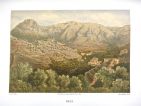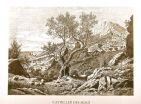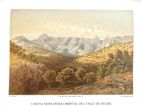
Deià and Llucalcari
 "Deià has 272 inhabitants and 74 houses, 2 of which are abandoned. It is somewhat similar to Sóller and, to an extent, offers a first impression of this earthly paradise. Deià stands out for its abundance of water, and we could say that it is attacked by springs of all types: here a noisy torrent, there a thunderous waterfall. Proportionally, it also exceeds Sóller in terms of aquifers. The houses are dispersed between orange trees and gardens with other fruit trees. Few houses are attached. If we also consider those in the surrounding area, their number rises to 281 and inhabitants to 800. The largest group is found in the depth of the valley at the base of the “puig” along with the exit from the old road on both sides of a stepped path, the only access to the town in olden times.
"Deià has 272 inhabitants and 74 houses, 2 of which are abandoned. It is somewhat similar to Sóller and, to an extent, offers a first impression of this earthly paradise. Deià stands out for its abundance of water, and we could say that it is attacked by springs of all types: here a noisy torrent, there a thunderous waterfall. Proportionally, it also exceeds Sóller in terms of aquifers. The houses are dispersed between orange trees and gardens with other fruit trees. Few houses are attached. If we also consider those in the surrounding area, their number rises to 281 and inhabitants to 800. The largest group is found in the depth of the valley at the base of the “puig” along with the exit from the old road on both sides of a stepped path, the only access to the town in olden times.
 The Town Hall is found on a small arched road, the only existing one in the town, with tree octagonal columns and from which an external staircase leads to the administrative offices.
The Town Hall is found on a small arched road, the only existing one in the town, with tree octagonal columns and from which an external staircase leads to the administrative offices.
Two paths climb to the top of this hill, in part rocky and the other worked into terraces and populated by olive and almond trees everywhere. One leaves from the aforementioned Porxo road and passes along the convent still under construction. The other leaves from Porxo behind the old Des Molí inn, today the residence of nuns. Along both cobblestoned and stepped paths are houses, some of which are new.
The main entrance to the church is in front of the open cemetery. Its modest chapel has a simple rosette and portal without ornamentation. The dark interior measures 29 meters long and 7 wide. It has a choir above the entrance and four chapels on either side, the first on the right occupied by a side entrance. It has a great deal of marble, such as the stone used for the main altar’s 6 columns with its red veins. All the construction material was extracted from the quarry near the town. The old square tower to the right of the temple, with two half-point arches on one side and only one arch on the other, was built as a place of refuge and defense against attacks by Moorish pirates.
Deià’s surroundings are unfailingly beautiful in any direction. Orange trees alternate with almond, walnut and other fruit trees, giving splendor to the multitude of terraces into which this fertile soil has been worked, their separating walls frequently covered in ivy. To this refreshing southern exuberance, we have to add the craggy rosary of Puig de Can Prom, Teix, Deià’s Son Moragues and Puig Gros des Molí, all populated by olive and carob trees.
Amongst the “possessió” houses closest to the towns and a few steps from Porxo road, we find the Son Canals house with its square tower, belonging to Antoni Vives, and just in front of the one belonging to the latter’s father. There is also the attached Son Moragues house, a modern building belonging to the Catalan, Monlau, who lives in Palma. Both take advantage of a spring which waters the neighboring “horts” (gardens) and their fruit trees. From Son Moragues’ tower overlooking the road to Sóller, there is a good view of the valley with the “puig” and the distant sea. From an equally dominant position is the old, square Can Fusumany house with its old laurel trees. It belongs to several owners. Both from here and the road near the public washing facilities we can easily reach the group of houses called Del Racó under the shade of numerous and good-sized walnut and cherry trees. The fast-flowing Font des Racó spring hurriedly dumps its water into a torrent parallel to the road, causing numerous cascades and moving a mill at the foot of the road.
 From Es Molí, a stone-paved and stepped path climbs up the steep valley and leads to Son Rullán, leaving the Can Borràs house belonging to the former on the right.
From Es Molí, a stone-paved and stepped path climbs up the steep valley and leads to Son Rullán, leaving the Can Borràs house belonging to the former on the right.
 Continuing our walk from Son Rullan, the top of Castellet des Molí emerges on the left, with an esplanade surrounded by large blocks of grey stones at its back in which some old olive and carob trees grow. Behind it, a hill crowned by pine trees joins the grey Teix mount, its shadows darkening a part of Deià Valley. From that esplanade, a partially stone-paved path begins. It winds amongst the rocky blocks and, after passing a type of flat, conglomerate rock platform, climbs steeply to the fantastic, little tower-shaped fortress on the top of the outcropping. How the ivy and carob trees knot themselves in this tortured landscape! A small staircase and then steep path lead through a square door. The wall is more or less round and, in the center, a rocky cone rises up. From here is a complete view of the entire valley, the coast with Cap Gros de Sóller cape and the Teix range.
Continuing our walk from Son Rullan, the top of Castellet des Molí emerges on the left, with an esplanade surrounded by large blocks of grey stones at its back in which some old olive and carob trees grow. Behind it, a hill crowned by pine trees joins the grey Teix mount, its shadows darkening a part of Deià Valley. From that esplanade, a partially stone-paved path begins. It winds amongst the rocky blocks and, after passing a type of flat, conglomerate rock platform, climbs steeply to the fantastic, little tower-shaped fortress on the top of the outcropping. How the ivy and carob trees knot themselves in this tortured landscape! A small staircase and then steep path lead through a square door. The wall is more or less round and, in the center, a rocky cone rises up. From here is a complete view of the entire valley, the coast with Cap Gros de Sóller cape and the Teix range.
If from the valley we were to decide to descend, instead, towards the sea, we could do so from both sides of the “puig”. One path passes alongside Son Bauçà, while the other crosses Son Bujosa.
Back on the road, higher up and to the right we come to the small house hidden amongst olive trees and belonging to En Tomeu de Cafè. We can see the welcoming Lluc Alcari or Es Carrer, to which a stone path leads. Projects are underway to convert this path into a road.
To the left of a type of road lined by a group of houses is the public church dedicated to Our Lady of the Forsaken (Mare de Déu dels Desamparats). This little church has a small arch serving as bell tower and a facade with corbel. Its modest vault ceiling is held up by two large ogive arches. The only altar is presided over by a painting of the Mother of God loaded with jewels and protected by angels. It dates from 1688 and is a symbolic copy of a statue.
Rarely are we privileged to enjoy the shapes and color of an image as pretty as Lluc Alcari, where everything is calm and wellbeing. It is one of those places where walkers would happily lay down their walking sticks to establish their homes. Also from the top of the road, the singular beauty of that country estate with its old towers stands out, found amidst slopes populated with olive and carob trees. The former are famous not for their abundant production but the exquisite quality of their oil and the immediate presence of the blue sea as the backdrop.
 Where the old path to Sóller beings its climb to Can Prom, the old Castelló church is surrounded by aromatic pomegranates. The church was built by the inhabitants of this estate, the old Castelló farmhouse, in the last years of the 17th century. It has a vaulted ceiling supported on a single arch. Today it is partially in ruins and deserted; its door, normally closed, is completely rotten. We don’t know who the church was dedicated to, but there is an image of Saint Peter Nolasco above the altar, and representations of the Conception of the Virgin Mary and the Holy Family on the sides.
Where the old path to Sóller beings its climb to Can Prom, the old Castelló church is surrounded by aromatic pomegranates. The church was built by the inhabitants of this estate, the old Castelló farmhouse, in the last years of the 17th century. It has a vaulted ceiling supported on a single arch. Today it is partially in ruins and deserted; its door, normally closed, is completely rotten. We don’t know who the church was dedicated to, but there is an image of Saint Peter Nolasco above the altar, and representations of the Conception of the Virgin Mary and the Holy Family on the sides.
From Can Bleda, and especially from Can Prom, there is a spectacular panoramic view: the mountains of Sóller Valley, grey and barren in the distance with the deep wounds of its ravines and extending from Puig Major to the right until joining the Serra de Alfàbia range."
Archduke Ludwig Salvator of Austria. Las Baleares por la palabra y el grabado. Majorca: The island. Ed. Sa Nostra, Caja de Baleares. Palma de Mallorca. 1982.






















